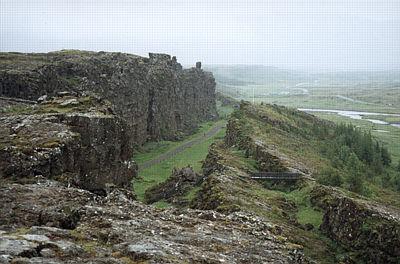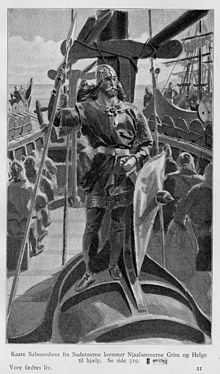The Trial of Kari Solmundarson et al vs Flosi et al
(“The Burnt Njal Trial”)(Iceland, c. 1012)

For farmer Njal Thorgeirssson of Bergthorknoll it could hardly have ended worse: burned alive with his family in his own home by a small army of his enemies. What preceded the tragedy is a long story; what came after is no less so. The tale of Njal, and an account of the trial of his murderers that follows, as well as the ramifications that come after that, make up the greatest of all Icelandic sagas, Njal’s Saga. Written by an unknown author around 1280, Njal’s Saga is an intense, violent, and epic narrative about men and women who made Iceland home. With almost three centuries separating the writing of the saga from the actual events, it is best to think of Njal’s saga as a cross between history and an historical novel.
Background
Njal’s saga recounts an escalating feud between Icelandic settlers—settlers who are neither especially good nor bad, but have differences that grow from small resentments to, eventually, violent and deadly encounters. The saga opens in about 960. Troubles really begin when a Hrut, his pride wounded by the decision of his wife, Unn, to divorce him, refuses to return her dowry, as was customary in Iceland at the time. When Unn falls upon hard times, she enlists the help of her cousin, Gunnar, who eventually succeeds in getting Hrut to return the dowry.
Gunnar becomes something of a big man in Iceland, returning rich and triumphant from adventures abroad. In 974 at Iceland’s annual national assembly, the Althing, Gunnar falls for and marries a woman named Hallgerd, much to the dismay of his friend Njal, who thinks Hallgerd is a big bag of trouble. Soon Hallgerd and Njal’s short-tempered wife, Bergthora, are at each other’s throats. The feud eventually leads to a killing match that leaves seven men dead.
True to Njal’s prediction, Hallgerd continues to scheme to make his friend Gunnar’s life as miserable as possible. For example, Hallgerd steals food from a farmer, leaving Gunnar to plead unsuccessfully with the difficult farmer to accept his generous offers of compensation for the stolen food. Before long, poor Gunnar seems to have a target on his back. Sentenced, unjustly one could well argue, to outlawry (a sort of banishment from society), Gunnar defies the order and his attacked at killed in his own home in 990.
The focus of the feud after 990 shifts to Njal and his family. Njal’s eldest son, Skarp-Hedin, avenges Gunnar’s death. Meanwhile, his two younger sons get embroiled in a peck of troubles in Norway. The sons of Njal, accompanied by a relative and a Norseman, kill one of their arch-enemies, Thrain, in 995.
Njal tries to head off vengeance of Thrain’s supporters and kinsment by adopting the son of Thrain, Hoskuld. Njal works tirelessly to promote Hoskuld’s advancement to chieftaincy. (The saga pauses about this point to describe the conversion of Iceland in the year 1000 form paganism to Christianity, by parliamentary decree.)
Njal’s sons, however, have a hard time accepting the growing power and popularity of Hoskuld. They attack and kill Hoskuld in a cornfield one spring day in about 1011. Njal tries to work things out with Flosi, the chieftain most angered by the killing of Hoskuld. But arbitration falls apart at the Althing when a well-intentioned gesture by Njal is misinterpreted.
Things quickly spin out of control. Flosi and a hundred men descend on Njal’s home. With Njal and his son inside, trying as best they can to mount a defense, the house in set on fire. All inside die except for Njal’s nephew, Kari, who climbs to the rafters and leaps from the roof with his hair and clothes ablaze. Kari plunges into a nearby stream, but is left disfigured and in pain from severe burns. Kari’s mission becomes seeking revenge for the deaths of Njal and his other relatives.
The Trial

Feuds can be destructive of society. At the turn of the millennium, religious and secular authorities in Iceland hoped that a legal system might break, or at least slow, the tide of violence. When Kari spreads the news of the awful fire, he gets surprising advice from a foster son of Njal, Thorhall Asgrimsson. He tells Kari they should take the murderers to court.
When Flosi receives notice of the suit, he considers settlement, but is persuaded by another member of the gang of arsonists that they should instead hire their own lawyer. Flosi visits Eyjolf Bolverksson, the most highly-regarded lawyer in all of Iceland, and asks him if he will take their case. Eyjolf, described in the saga as bedecked in a scarlet cloak and gold headband, initially turns down Flosi’s request. But Flosi’s offer of a splendid gold chain for his services causes him to reconsider. He tells Flosi that he will take the case. At the time, however, accepting compensation for legal services was considered improper—so one could guess where the saga might be going. Eyjolf will come to regret his decision to defend Flosi and his gang.
Trials in Iceland took place at Law Rock, a beautiful spot between a lava cliff and a wide valley sliced by a shining river. On the actual rock, once each summer, the Law Speaker recites to everyone present one-third of Iceland’s legal code. (The next summer, he will recite a different third of the code, and in the third year, he will complete his recital before starting over again the next year.) When a case was to be heard, lawyers would gather in their respective booths, while around them circulated jurors and interested spectators.
In Kari’s trial, Kari’s nine jurors seated themselves on the ground. They are present not to weigh facts, but rather to swear that Kari followed proper legal procedures in bringing his suit. All become silent when Kari’s lawyer, Mord Valgardsson, stepped up to Law Rock. In what we might call his “opening statement,” Mord announced that he will plead truly, fairly, and in accordance with the law. He then asked witnesses to swear he had been lawfully appointed and that the defendants had been given notice of the suit. He then asked if anyone had any objections.
Eyjolf Bolverksson was ready. He argued that two of the jurors should be disqualified on the ground they are related to him. Mord had no answer to the objection and the suit seemed on the verge of dissolving. But one man might have the answer: Thorhall Asgrimsson. Thorhall, to his great consternation, could not attend the court proceedings because of an ugly leg inflammation that had left him bedridden.
Messengers rushed to Thorhall’s home, got his legal advice, and then passed it on to Mord. Mord stood to refute Eyjolf’s argument for disqualification. He said that only kinship with the accuser, not with a defense attorney, required a juror to step down.
Sadskat Kadri, in his lively account of the trial, notes that all around considered Mord’s response “brilliant,” but that Eyjolf “pulled another arrow from his quiver.” Eyjolf argues that home ownership is a requirement for jurors, but that two of Kari’s jurors are not homeowners. Once again, messengers ride off to Thorhall and come back with his rejoinder: ownership of a cow is sufficient to establish eligibility to serve as a juror. This claim turned out to be a matter of dispute, and so the question is put to the Law Speaker, Skapti Thoroddsson. He emerged from his booth to announce his decision. A cow, indeed, will do.
Eyjolf has one last trick up his sleeve. Jurors, in Iceland, are the men living closest to the scene of the crime. (Note that in Medieval Iceland, the legal system expected jurors to be the people most knowledgeable about a crime, not—as seems the preference in our system—people with almost zero knowledge of the crime.) Eyjolf argued for disqualification of four jurors who, he said, lived more distant to the scene of the crime that others not asked to serve as jurors.
Yet again Mord had an answer. He said cases could be decided by a majority of the nine jurors, and five still remain. The Law Speaker seemed stunned. He believed he was the only person in all of Iceland who knew this fine legal point, but—yes—five jurors would suffice.
With issues of juror eligibility finally behind him, Eyjolf proceeded to his next argument, a jurisdictional claim. He argued that the case had been brought before the wrong division of the Law Rock. This turned out to be true, but resulted in only a short delay as Kari’s team refiled the case.
The prosecution (that is, Kari’s side) now took to offense, contending that Eyjolf was guilty of bribery for accepting the gold bracelet as payment for his services. But what could have been a knockout blow became irrelevant in light of a serious legal error by Mord. Mord demanded that six of the 36 judges in the case stand down and that the remaining judges award Kari’s side the verdict. But for reasons that only the best scholar of Medieval Icelandic jurisprudence might fathom, this was a mistake. Mord should have asked to remove twelve judges, not six. The legal blunder meant that Kari and the other of Njal’s kinsmen, far from winning their case, faced exile!

Even Thorhall had no remedy for this problem. Instead, he roused himself from his bed and, blood pouring down his leg, made way for Law Rock. Thorhall, despite being an admired jurist, evidently had had it with legal maneuverings. When he encountered Grim the Red, a member of Flosi’s legal team, he plants a spear into the man, splitting his shoulder blades in two. Then all hell broke loose. The fact that such a gravely injured man as Thorhall was moved to action inspired other members of Kari’s side to fight. Soon, as Kadri describes it, “Across the Law Rock, weapons fly, bones crack, body parts are pierced, and at least one bystander is hurled headlong into a boiling cauldron.” When the Law Speaker proposed a cease-fire negotiation, his answer was a spear through both his calves. The action reached its climax when Eyjolf Bolverksson was spotted by one of Kari’s supporters. “Reward him for that bracelet,” the friend suggested to Kari. Kari launches a spear that cuts clean through the pleader’s waist.
The next morning, after the dead were buried and wounds bound, some of the trial participants returned to Law Rock. It was for one of Flosi’s team to state the obvious: “There have been harsh happenings here, in loss of life and lawsuits.”
Trial Aftermath
A truce of sorts followed the bloodshed. Eventually a settlement was reached, accepted by nearly all of the trial participants. Kari and one other nephew of Njal were the holdouts. The burners of Njal’s home are sent into exile.
The Icelandic Commonwealth, with the Law Rock at the center of the annual gathering of Icelanders, remained in place until 1262. In 1262, Icelanders took allegiance to the king of Norway. No longer could it be said of Icelanders, as Adam of Bremen said in the eleventh century, “they have no king except the law.”
No one could contend Kari v Flosi trial of about 1012 was typical. But the trial does suggest a time and placed every bit as obsessed with legal formalities as our own legal system today. Kadri observes in his excellent book, The Trial, that “so much as word out of place could cost the speaker a fine, the case, or his life.” Cases were as likely to be decided by the correctness (or incorrectness) of legal procedure as they were by actual testimony.
